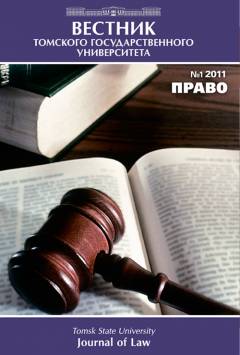Ecologically neglected territories in international, foreign and Russian law: comparative and legal aspect
The article states that in the modern world full of industrial, technical, military and other facilities, accidents and catastrophes resulting in a huge harm to the nature and health of the people are inevitable. Global climate changes result in the emergence of unprecedented droughts, floods and other natural disasters. These problems require urgent solutions; however, the priority of economic interests over the ecological ones in Russia results in extremely serious consequences for life, health of citizens and threatens national security. The changing position of the international community is very significant and this will demand the revision of the existing ideas about the category of "disaster" in international law, with inclusion of the catastrophic ecological situations, which are not connected with concrete accidents and catastrophes. The legal regime of ecologically neglected territories in Russia (unlike a number of republics of the former USSR) suffers from extreme uncertainty and in this connection (and in view of cutting funds for environmental protection) no zone of ecological catastrophe or an emergency ecological situation was created here. Thus, the rules of other laws extending to zones of ecological disaster have not come into force yet. Article 250 of the Criminal Code of the Russian Federation considers the commission of such a crime as pollution of water in a zone of ecological disaster or of an emergency ecological situation to be a characterizing feature and this leads to a more strict liability. However, there are no such zones, and, therefore, Item 2 of this Article cannot be applied, and this is not the only example. Besides, when reforming the Russian ecological legislation it is necessary to take into account the experience of other CIS countries providing in their ecological laws for not one ( as in Russia) ,but different types of territories of ecological trouble (zone of ecological disaster). This allows giving a special ecological legal status and taking a complex of recovery measures to problem territories where a full-scale environmental disaster has not happened yet. Moreover, it is necessary to differentiate categories "an emergency situation" and "a zone of ecological disaster" since not every emergency situation can give rise to a long-term ecological crisis on the considerable territory that demands the acceptance of a complex aggregate of recovery measures.
Keywords
accident,
human rights,
criteria,
zone of ecological disaster,
emergency situation,
ecologically neglected territories,
авария,
права человека,
критерии,
зона экологического бедствия,
чрезвычайная ситуация,
экологически неблагополучные территорииAuthors
| Anisimov Alexey P. | Volgograd Institute of Management | anisimovap@mail.ru |
Всего: 1
References
Определение Верховного Суда РФ от 07.07.2003 г. по делу № 46-Г03-10 // СПС «Консультант плюс» (дата обращения: 23.01.2018).
Попугаева М.В. Правовое обеспечение вывода территории Самарской области из состояния экологического бедствия (вопросы теории и практики) : автореф. дис.. канд. юрид. наук. Саратов, 2005.
Государственный доклад о состоянии и охране окружающей среды в Красноярском крае за 2009 год. Красноярск, 2010.
Решение Карабашского городского суда по делу № 2-5/2011. URL: https://rospravosudie.com/court-karabashskj-gorodskoj-sud-chelyabinskaya-oblast-s/act-100886631/ (дата обращения: 26.01.2018).
Дзугаев М.Д. Карабаш - город «экологического бедствия» // Вестник Челябинского государственного университета. Серия Право. 2003. Т. 9, № 2. С. 92-96.
Методика «Критерии оценки экологической обстановки территорий для выявления зон чрезвычайной экологической ситуации и зон экологического бедствия» (утв. Минприроды РФ 30.11.1992) // СПС «Консультант плюс» (дата обращения: 25.01.2018).
Рыженков А.Я. Правовой режим зон экологического бедствия // Современное право. 2014. № 7.
Саввич Н.Е., Трунцевский Ю.В. Экологическое право : учеб. пособие. М. : ЮрИнфоР, 2001.
Закон Республики Узбекистан от 9 декабря 1992 г. № 754-XII «Об охране природы» (ред. от 14.09.2017). URL: http://base.spinform.ru/show_doc.fwx?Rgn=838 (дата обращения: 25.01.2018).
Закон Кыргызской Республики от 16 июня 1999 г. № 53 «Об охране окружающей среды» (ред. от 25.07.2016). URL: http://base.spinform.ru/show_doc.fwx?rgn=293 (дата обращения: 25.01.2018).
Бекишева С.Д. Правовое регулирование экологически неблагополучных территорий по Экологическому кодексу Республики Казахстан // Права человека и проблемы безопасности общества и личности в современной России : материалы II Межрегион. науч.-практ. конф., Волгоград, 4-5 декабря 2008 г. Волгоград, 2009. С. 160-165.
Экологический кодекс Республики Казахстан от 9 января 2007 г. № 212-III ЗРК (ред. от 15.06.2017). URL: http://online.zakon.kz/Document/?doc_id=30085593 (дата обращения: 25.01.2018).
Закон Республики Беларусь от 26 ноября 1992 г. № 1982-XII «Об охране окружающей среды» (ред. от 17.07.2017). URL: http://online.zakon.kz/Document/?doc_id= 30450550#pos=0;200 (дата обращения: 25.01.2018).
Болтанова Е.С. Правовой режим зон экологического бедствия и зон чрезвычайной ситуации // Экологическое право. 2017. № 1. С. 33-39.
Постановление Правительства РФ от 21 мая 2007 г. № 304 «О классификации чрезвычайных ситуаций природного и техногенного характера» (ред. от 17 мая 2011 г.) // СПС «Гарант» (дата обращения: 24.01.2018).
Каспрова Ю.А. Экологически неблагополучные территории: особенности правового режима : автореф. дис.. канд. юрид. наук. М., 2014.
20 историй успеха снижения риска стихийных бедствий из опыта Центральной Азии. URL: http://www.unisdr.org/files/2300_20GoodExamplesofGoodPracticeruss1.pdf (дата обращения: 25.01.2018).
Руководство по снижению риска стихийных бедствий на уровне сообщества в Центральной Азии, 2006. URL: http://www.unisdr.org/files/2299_ACommunity Guiderus1.pdf (дата обращения: 25.01.2018).
Снижение риска бедствий с учетом гендерного аспекта. Стратегия и практическое руководство. Женева : МСУОБ ООН, ПРООН и МСОП, 2009. 177 с.
Послание Генерального секретаря ООН по случаю международного дня по уменьшению опасности бедствий от 13 октября 2014 года. URL: http://www.unisdr.org/2014/iddr/documents/IDDR14.SGMessage_Russian.pdf (дата обращения: 25.01.2018).
Осуществление Хиогской рамочной программы действий в Азиатско-Тихоокеанском регионе. Предметное исследование: национальная система борьбы с бедствиями в Китае и ее ответ на землетрясение в Вэньчуане. URL: http://www.une-scap.org/idd/events/cdrr-2009/CDR_2R.pdf (дата обращения: 25.01.2018).
Протоколы. III Всемирная конференция ООН по снижению риска бедствий. 1418 марта 2015 г. / Сендай, Япония. URL: http://www.unisdr.org/files/45069_proceedin-gsthirdunwcdrrru.pdf (дата обращения: 25.01.2018).
